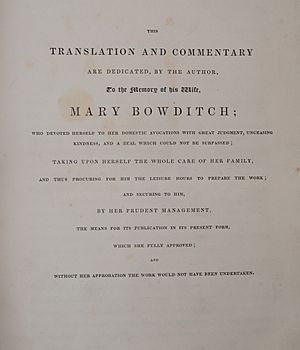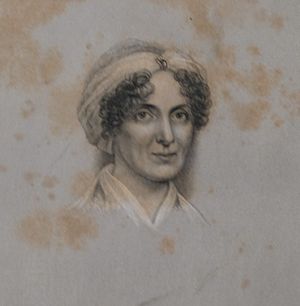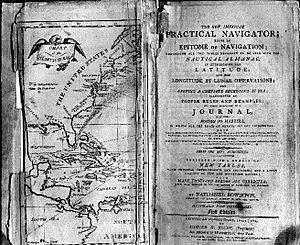Nathaniel Bowditch facts for kids
Quick facts for kids
Nathaniel Bowditch
|
|
|---|---|

Bowditch is often credited as the founder of modern maritime navigation.
|
|
| Born | March 26, 1773 |
| Died | March 16, 1838 (aged 64) Boston, Massachusetts, US
|
| Occupation | Mathematician, ship's captain, and actuary |
| Spouse(s) | Elizabeth Boardman Bowditch, Mary Polly Ingersoll Bowditch |
| Signature | |
 |
|
Nathaniel Bowditch (born March 26, 1773 – died March 16, 1838) was an important American mathematician. He is famous for his work on how ships find their way across the ocean, called navigation. Many people say he started modern sea navigation. His most famous book, The New American Practical Navigator, was first published in 1802. Even today, every ship in the U.S. Naval fleet carries a copy of this book! In 2001, a school in Salem was named after him to honor his achievements.

| Top - 0-9 A B C D E F G H I J K L M N O P Q R S T U V W X Y Z |
Nathaniel Bowditch's Early Life & Learning
Nathaniel Bowditch was born in Salem, a town in the Province of Massachusetts Bay. He was the fourth of seven children. His father, Habakkuk Bowditch, was a cooper (someone who makes barrels). When Nathaniel was just ten years old, he had to leave school to help his father.
At age twelve, he started an apprenticeship for nine years. He worked for a ship chandler, a person who sells supplies for ships. This is where he first learned bookkeeping, which is about keeping financial records. This skill was very important for his future.
How Bowditch Taught Himself
Nathaniel was very smart and loved to learn on his own. At 14, he began studying algebra. Just two years later, he taught himself calculus, a very advanced type of math. He also learned Latin in 1790 and French in 1792. This allowed him to read important math books, like Isaac Newton's Philosophiae Naturalis Principia Mathematica.
He even found thousands of mistakes in a popular navigation book called The New Practical Navigator. When he was 18, he copied all the math papers from the Philosophical Transactions of the Royal Society of London. Later, he would translate a huge math and astronomy book called Mécanique céleste by Pierre-Simon de Laplace. This translation was key for astronomy in the United States.
Nathaniel also got lucky! He was able to use a large library belonging to a famous chemist, Richard Kirwan. This library had been captured by a privateer (a legal pirate) from Salem and brought back to the town.
Life at Sea and Back Home
In 1795, Bowditch started sailing. He went on four voyages as a ship's clerk and writer. His fifth voyage was as a ship's master and part owner of the ship. After this, he returned to Salem in 1803. He wanted to continue his math studies and started working in the insurance business.
One of his family homes in Salem, the Nathaniel Bowditch House, is still standing today. It was restored in 2000 and is now a National Historic Landmark.
Family and Achievements
In 1798, Bowditch married Elizabeth Boardman, but she sadly died seven months later. In 1800, he married his second wife, Mary "Polly" Ingersoll Bowditch. They had eight children together.
In 1802, his famous book The American Practical Navigator was first published. In the same year, Harvard University gave him an honorary degree to recognize his amazing work.
In 1804, Bowditch became America's first insurance actuary. An actuary is someone who uses math to figure out risks and prices for insurance. He became president of the Essex Fire and Marine Insurance Company in Salem. Under his leadership, the company did very well, even during tough times like the War of 1812.
Growing Reputation and New Opportunities
Bowditch's math and astronomy work made him very well-known. He was elected to important groups like the American Academy of Arts and Sciences in 1799. He was even offered a job as a math and physics professor at Harvard in 1806, but he said no.
He published many scientific papers. These included observations of the Moon (1804), naval charts of harbors (1806), a study of a meteor explosion (1807), and papers on the paths of comets (1815, 1818, 1820). He also studied the cool patterns made by a pendulum swinging from two points (1815).
In 1816, Harvard gave him another honorary degree, a Doctor of Laws. Other famous schools like the United States Military Academy and the University of Virginia also offered him math professor jobs. But Bowditch turned them down again, perhaps because the salaries were less than what he earned at the insurance company.
His translation of Laplace's Traité de mécanique céleste was finished by 1818. It took many years to publish because it was so expensive. He kept working on it with help from Benjamin Peirce, adding comments that made the book twice as long!
By 1819, Bowditch was famous around the world. He was elected as a member of the Royal Societies of Edinburgh and London, and the Royal Irish Academy.
In 1823, Bowditch left the insurance company in Salem. He moved to Boston to become an actuary for the Massachusetts Hospital Life Insurance Company. Here, he managed money for wealthy people who had made their fortunes at sea. He helped direct their money into new businesses, which helped towns like Lowell grow and prosper.
When Bowditch moved from Salem to Boston, he brought with him over 2,500 books, 100 maps, and 29 volumes of his own handwritten notes!
Bowditch's American Practical Navigator
While he was sailing, Bowditch became very interested in the math used for celestial navigation. This is how sailors use the stars and sun to find their way. He first used a book called Navigator by John Hamilton Moore, but he found it had many errors. To make sure his tables were perfect, Bowditch recalculated all of Moore's tables. He also reorganized and added a lot more information to the book.
He contacted the American publisher, Edmund March Blunt, who asked him to fix and update the book. The job was so big that Bowditch decided to write his own book instead. He said he would "put down in the book nothing I can't teach the crew." It's said that on that trip, every one of the 12 crew members, even the ship's cook, learned how to use the stars to figure out the ship's exact location!
In 1802, Blunt published the first edition of Bowditch's American Practical Navigator. For the next 150 years, this book became the main guide for shipping in the Western Hemisphere. The book included new ways to solve problems in spherical triangles (a type of geometry used in navigation), along with many formulas and tables.
In 1866, the United States Hydrographic Office bought the copyright. Since then, the book has been printed continuously, with regular updates to keep it current. Bowditch's impact on the American Practical Navigator was so strong that sailors still call it simply Bowditch. Young naval officers even called it "the immaculate Bowditch" because it was so accurate.
Nathaniel Bowditch's Legacy
Nathaniel Bowditch passed away in Boston in 1838 from stomach cancer. He is buried in Mount Auburn Cemetery, where a monument was built for him using money collected from the public.
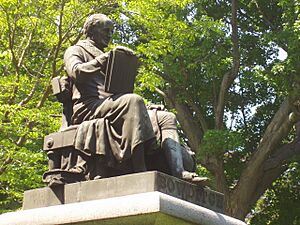
The statue was the first life-size bronze statue ever made in America. It was created by the famous sculptor Robert Ball Hughes.
The Salem Marine Society wrote a beautiful tribute to him, saying that he was a "public, a national, a human benefactor." They said that as long as ships sail and stars shine, his name would be remembered as someone who helped people find their way across the oceans.
After his death, Nathaniel's son, Dr. H. I. Bowditch, ran the "Bowditch Library" in Boston. It was free for people in Boston and nearby areas. This library held Nathaniel Bowditch's own collection, which was mostly about math and astronomy. In 1858, the family gave this valuable collection to the Boston Public Library.
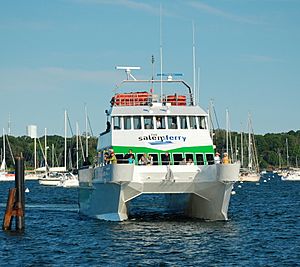
Many things have been named after Nathaniel Bowditch to honor his contributions:
- The Oceanographic Survey Ship USNS Bowditch.
- The Nathaniel Bowditch, a fast catamaran passenger ferry that travels between downtown Boston and Salem.
- A crater on the Moon.
- A Schooner (a type of sailing ship) built in 1922, which is now part of the Maine Windjammer fleet.
- A book for younger readers, Carry On, Mr. Bowditch, published in 1955 by Jean Lee Latham, which tells a dramatized story of his life.
- Schools in Boston, Foster City, California (Bowditch Middle School), and Salem, Massachusetts.
- A dorm at Salem State College.
- The Department of Marine Transportation building at the United States Merchant Marine Academy.
- A street in Berkeley, California.
- Bowditch Point Park in Fort Myers Beach, Florida.
In 2014, Nathaniel Bowditch was inducted into the National Sailing Hall of Fame.
See also
- Bowditch curve
- List of actuaries
- List of amateur mathematicians
- USS Bowditch


